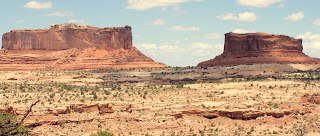From Canyonlands National Park, it is a short drive to Arches National Park. The entry to the park climbs along a a tall cliff. This piece of strata balances precariously on a shoulder.
As does this even more ominous looking boulder. We don't want to be there when either tumbles.
Unusual rock formations abound here. This is Courthouse Towers.
A short distance away is Balanced Rock. To give some perspective on the size of this formation; the rock on top has the volume of three school busses and weighs as much as 1600 full sized cars.
We did not find a name for this formation. We called the rock to the left, "The Pharoah".
At Park Avenue three different strata are clearly visible. The Curtis formation, at the top, is the youngest. It was deposited as dunes on a beach. Beneath that is slick rock of the Entrada formation. It dominates the park and is the stone from which most of the arches are formed. This was sandstone deposited when the area was a vast desert. The oldest and softest layer at the bottom is the Carmel formation. It was deposited when this area was a tidal flat.
A thick layer of salt, left by the evaporation of ancient seas, liquified under the tremendous pressure of the weight of the overlying rocks. Often the salt was pushed up into domes. When fins formed in the rocks that comprised the domes and the salt was washed away, arches were left. This is the Turret arch. There are over 2,000 arches in the park. The smallest is three feet wide.
We drove back to our coach on UT Hwy 128 along the banks of the Colorado River. The setting sun cast intriguing shadows on the walls of the canyon. The road was windy and there was something unique around every corner. We even saw a dude ranch and a vineyard.
As evening fell, we turned onto I-70, drove back to our coach and began a desperate search for superlatives to describe what we had seen. We found none that were adequate. Photos are inadequate. You need to see it for yourself. How can you see this and not want to learn more about geology? The teacher, Penny, and the scientist, Ted, wish every student could see this and so much of what we have seen, in person, especially with an experienced guide. Education would become an adventure.


























































